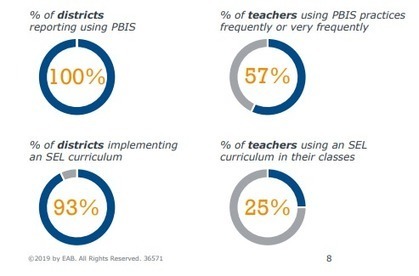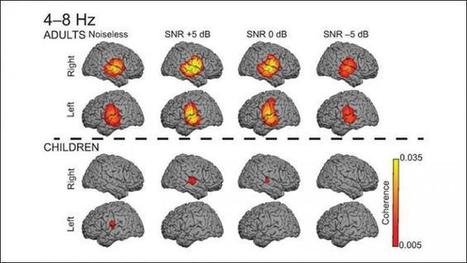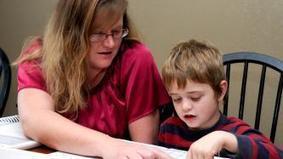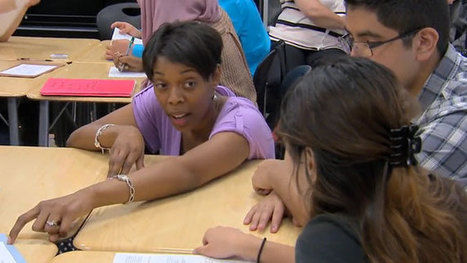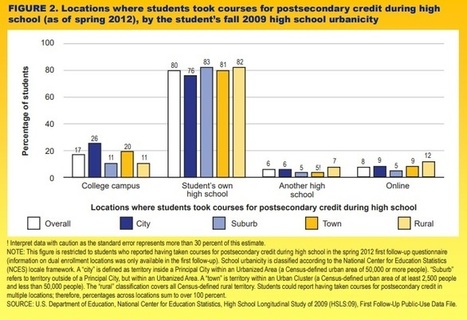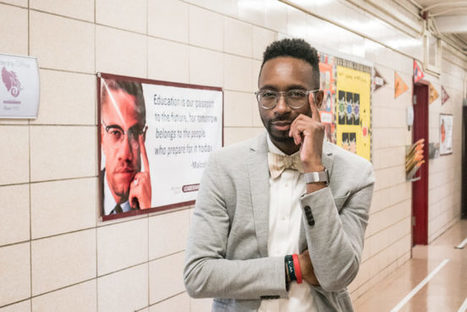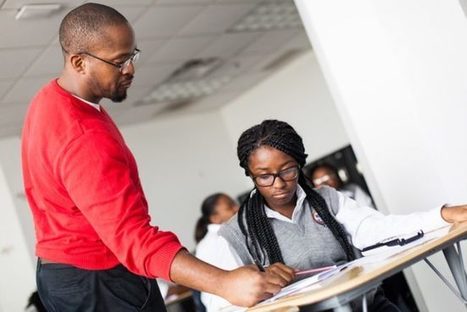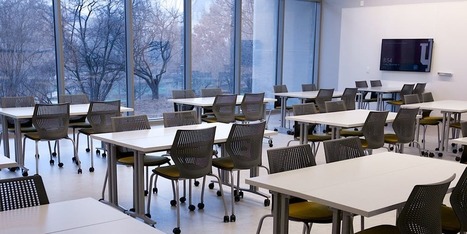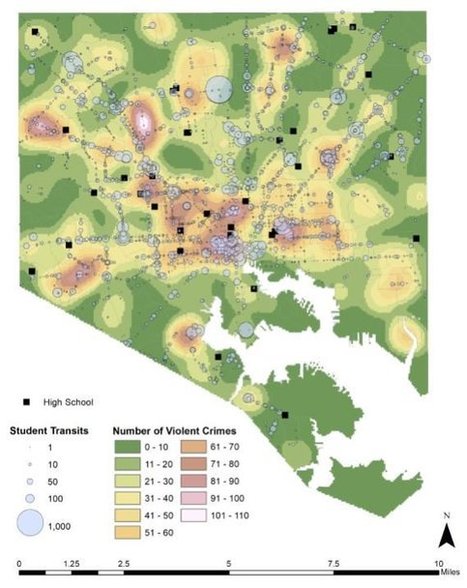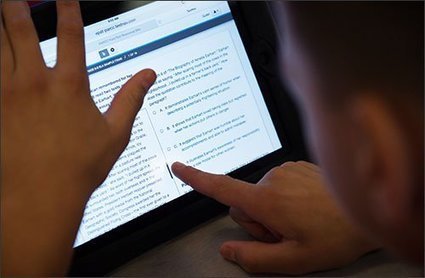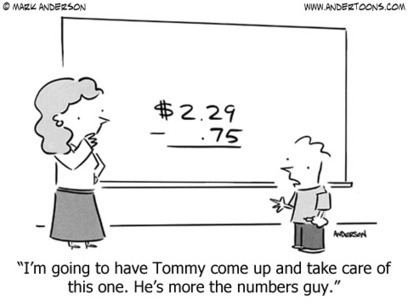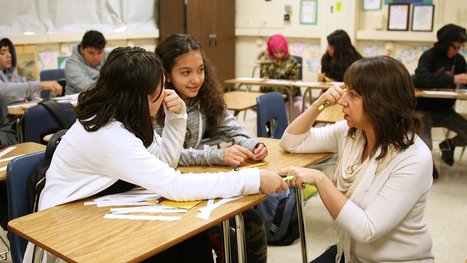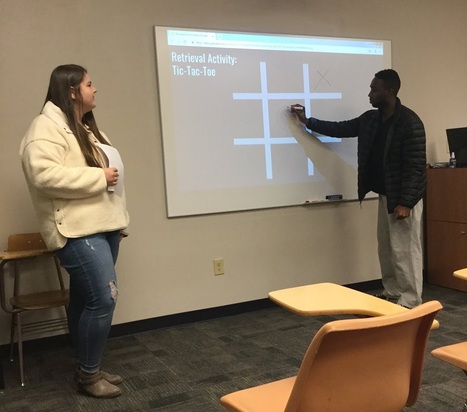 Your new post is loading...
 Your new post is loading...

|
Scooped by
Mel Riddile
|
Teams are complex systems of individuals with different preferences, skills, experiences, perspectives, and habits. The odds of improving that complex system in a meaningful and sustainable way are higher if every team member — including the leader — learns to master these three foundational capabilities: internal self-awareness, external self-awareness, and personal accountability.

|
Scooped by
Mel Riddile
|
One of the most glaring findings from the study was that at the district level people would say 'We are doing PBIS; we are doing SEL'... " said Pete Talbot, the managing director of K-12 research at EAB. "The question is, 'What is the consistency with which it's being implemented from school to school within a district, and within the school? What's the degree of fidelity down to the classroom level?'.... I think that's one of the biggest areas for improvement for districts. It's not enough to simply do a one-time training or allow schools to go their own way."

|
Scooped by
Mel Riddile
|
Early reading instruction in the United States focuses heavily on teaching students phonics. These results seem to suggest that students may have a more difficult time distinguishing phonemes and following speech or instructions as classroom noise rises, and highlights the importance of quiet classrooms while children are learning to recognize language, said Marc Vander Ghinst, the lead author and a researcher at a developmental neuroscience center at the Free University of Brussels, in Belgium.
"The more teachers take time to do a correct pronunciation, the better the student understands," he said. "Furthermore, it has been demonstrated that this also brings a better speech representation in the brain. My advice would be: Take the time to do a correct pronunciation, and try to do it in a calm atmosphere."

|
Scooped by
Mel Riddile
|
Sometimes, research can promise much and deliver teachers little. It all looks good on paper, but try it out and it is more cataclysmic than a catalyst.
But some papers change the way you teach forever, and, for me, none have done that as comprehensively as Improving Students’ Learning With Effective Learning Techniques: Promising Directions From Cognitive and Educational Psychology (Dunlosky et al, 2013).

|
Scooped by
Mel Riddile
|
High school ELA teacher Monica Baines explains how she uses questioning as a means for discovery and as a way to assess and build her students' understanding. Monica explains how she uses connecting questions, and follow-up questions when working with students. Through questioning, Monica is able to differentiate and assess her students' progress.

|
Scooped by
Mel Riddile
|
How often do students come to you and exclaim, "But I studied for hours!" How can we help students improve their study habits? Before you give them strategies, there's one thing you have to do first: have a conversation. Here are our three must-ask questions to get started.

|
Scooped by
Mel Riddile
|
About a third of high school students took courses for college credit, according to a nationally representative study from the U.S. Department of Education. The new dual-enrollment data are based on a 2009 study of more than 23,000 ninth graders, whom the department surveyed again in following years.
The study found that students whose parents had higher levels of education were more likely to take courses for college credit while they were in high school. For example, 42 percent of high school students whose parents held at least a bachelor's degree took college courses, compared to 26 percent whose parents did not hold a high school credential. In addition, the study found that a lower percentage of Latino high school students (30 percent) and black students (27 percent) took dual-enrollment courses than did white or Asian American students (both 38 percent).

|
Scooped by
Mel Riddile
|
Computational thinking is the process of breaking down a complex problem into easy to understand parts. Essentially, computational thinking helps you break down a problem into bite-sized pieces that a computer could understand and ultimately help solve.
Computational thinking is not programming. Programming tells a computer what to do and how to do it. Whereas computational thinking is the process of figuring out what to tell the computer to do. Computational thinking is the process of thinking like a computer scientist.

|
Scooped by
Mel Riddile
|
Here’s a great video of Alonte Johnson, some time English Teacher and full time Dean of Curriculum and Instruction at Uncommon’s Leadership Prep Ocean Hill Middle Academy, that shows a high level model of one solution– we call it a “Responsive Turn and Talk” because the Turn and Talk is a response to a low number of hands.

|
Scooped by
Mel Riddile
|
Yesterday was one of the most intellectually intense days I’ve had in some time, and I came to realize some important things about Check for Understanding.
I’m going to try to summarize some of them here.
1) Check for Understanding is quite possibly the single most important group of techniques in terms of building relationships with students–I had never fully made that connection before and I suspect many other teachers hadn’t either.
I realized this over the course of a meeting with our TLAC Fellows in which we set out to discuss and study building relationships in the classroom- something my team and I are interested in studying because we think it’s an important topic and because we think it’s an oft-misunderstood or misapplied topic.
The first thing we realized was that many teachers focused their relationship building efforts on what happens outside of the core teaching–greeting students in the hallway and asking them about their interests.

|
Scooped by
Mel Riddile
|
Even when teachers focus on a strategy that is backed by evidence, they don’t implement it in the way supported by research. Rather than putting a difficult text in the foreground and modeling whatever strategies might help students extract its meaning, teachers put a strategy in the foreground and choose simple texts that lend themselves to demonstrating it, without regard to their topics. And they teach comprehension day after day, year after year—sometimes through high school. But studies have shown that after only two weeks of strategy instruction, students stop getting benefits.

|
Scooped by
Mel Riddile
|
Here’s a great video of Alonte Johnson, some time English Teacher and full time Dean of Curriculum and Instruction at Uncommon’s Leadership Prep Ocean Hill Middle Academy, that shows a high level model of one solution– we call it a “Responsive Turn and Talk” because the Turn and Talk is a response to a low number of hands.

|
Scooped by
Mel Riddile
|
classroom space always influences the implementation of active learning
|

|
Scooped by
Mel Riddile
|
It’s up to people who hold positions of privilege to be active allies to those with less access, and to take responsibility for making changes that will help others be successful. Active allies utilize their credibility to create a more inclusive workplace where everyone can thrive, and find ways to make their privilege work for others.
And wielding privilege as an ally doesn’t have to be hard. I’ve seen allies at all levels take action with simple, everyday efforts that made a difference—often a big one!

|
Scooped by
Mel Riddile
|
The researchers found that as violent crime increased in areas where students walked or waited for a bus, their attendance dropped. A doubling of the incidents of violent crime was associated with 6 percent higher student absenteeism—roughly an additional day missed for each student per year. Julia Burdick-Will, lead author of the study, noted that because the number of individual crimes is relatively low at any given bus stop, it's not that hard for students to face a sudden doubling of violent incidents during the school year.

|
Scooped by
Mel Riddile
|
Research shows that instructional leadership has a positive impact on student learning. For example, in Hattie's synthesis of meta-analysis (2009. 2012), which includes over 420 studies on school leadership, he found that instructional leadership was the most impactful way to lead a school (as opposed to transformational leadership, management, etc.) because it helps put a focus on learning. Hattie is far from the only researcher who has come to this finding, which is the direct result of his ability to synthesize over 420 studies on leadership.

|
Scooped by
Mel Riddile
|
Massachusetts students who took state exams online in 2015 scored significantly worse than their peers who took the same exams on paper, according to a new study by the American Institutes for Research.
The so-called "mode effect" was particularly pronounced in English/language arts, where the discrepancy amounted to nearly a full year of learning, AIR found. Lower-performing students, special education students, and English language learners suffered particularly sharp penalties when they took the ELA exams online.
In both ELA and math, however, the negative effects of taking the exams online diminished considerably during the second year of testing.

|
Scooped by
Mel Riddile
|
You’ve probably seen some version of this aphorism if you work in education: They Don’t Care How Much You Know Until They Know How Much You Care It’s s often given a sort of hallowed stature-it’s a truism & should shape our every decision in the classroom. Maybe that’s why it’s attribute

|
Scooped by
Mel Riddile
|
Lack of confidence in our ability to understand math can affect both students and teachers. Jerry Burkhart looks at some of the reasons why and what we can do. When math teachers talk about what they do for a living, the reply is often something like “Oh, I was never very good at math.” In fact, this lack of confidence in math ability seems so pervasive as to be more cultural than personal. As an experiment, try typing “I used to be good…” into a search engine. “I used to be good at math” will probably show up high (maybe even first) on the list of auto-completions! It appears that even people who start out feeling confident in math often lose this confidence over time.

|
Scooped by
Mel Riddile
|
In an animated video published by Education Week this fall, he explained that differentiating instruction is really about getting to know your students and being flexible with the ways they demonstrate their learning. It is not, in fact, about spending your evenings planning a separate lesson for each student.
Today, we're publishing two more videos about differentiation featuring Ferlazzo and veteran teacher Katie Hull Sypnieski. (They recently co-authored a book called The ELL Teacher's Toolbox.)
In the video below, Ferlazzo and Hull Sypnieski describe techniques they use to differentiate lessons for English-language learners. Those include strategies like pairing up students of different language levels and playing classroom videos at slower speeds.

|
Scooped by
Mel Riddile
|
Breaking words down to uncover meaning helps learning, says Aidan Severs as he offers five ways to introduce etymology
By Aidan Severs
04 February 2019
Share this
Facebook
Twitter
Linkedin
Email
"This lesson just got interesting," exclaimed one of my more vocal pupils.
No, I hadn’t just introduced the latest piece of edtech or revealed laminated resources that took me all evening to prepare.
I wasn’t even crouching in a home-made cage dressed as an elephant (yeah, I did that once).

|
Scooped by
Mel Riddile
|
The research is clear: Retrieval practice boosts learning. To get students on board, it's critical to emphasize that retrieval practice is a learning opportunity, not an assessment opportunity.
Classroom games, like Jeopardy and various apps (e.g., Kahoot, Quizlet, etc.) are engaging and low stakes – perfect for retrieval practice. But they can increase anxiety, too. When you were a student, did you ever feel pressured to come up with a correct answer to a question, as soon as possible, without disappointing your teammates? Talk about anxiety!

|
Scooped by
Mel Riddile
|
Can’t instructors just lecture sometimes? Can’t we ever just tell students what we know?
Of course we can, but it’s important to know what telling is good for — and what it’s not. If we can better understand the problem with relying too much on lecturing — or "continuous exposition by the teacher," as Derek Bruff, director of Vanderbilt University’s teaching center, called it — then we can better situate lectures within a mix of teaching practices.
When to "tell," and when not to. Say a friend calls to ask how you make that risotto you’re famous for. What do you do in that moment? Start in on the Socratic method and make her work to discover the recipe by herself? Or just tell her how you make it?

|
Scooped by
Mel Riddile
|
The Do Now
The first step in a great lesson is a “Do Now”– a short activity that you have written on the board or that is waiting for students as they enter. It often starts working before you do. While you are greeting students at the door, or finding that stack of copies, or erasing the mark-ups you made to your overhead from the last lesson, students should already be busy, via the Do Now with scholarly work that prepares them to succeed. In fact, students entering your room should never have to ask themselves, “What am I supposed to be doing?” That much should go without saying. The habits of a good classroom should answer, “You should be doing the Do Now, because we always start with the Do Now.”

|
Scooped by
Mel Riddile
|
Perceiving questions as different events teaches students to notice the differences between questions. In fact, a person who’s truly engaged in a discussion is often engaged because he or she attends to the differences among questions and becomes increasingly interested in those differences. A discussion, to that person, is not one event, but a series of fascinating events that come up in unpredictable order. To raise and lower your hand at each question is an acknowledgment that the questions are important and distinct; doing so also communicates respect for your peers because, as the first student demonstrated, you can’t really listen and have your hand up at the same time. A classroom where hands are up while someone is speaking is a classroom where people are saying, essentially, “What you’re saying doesn’t matter much to me; it won’t change what I want to say.”
|
 Your new post is loading...
Your new post is loading...
 Your new post is loading...
Your new post is loading...






